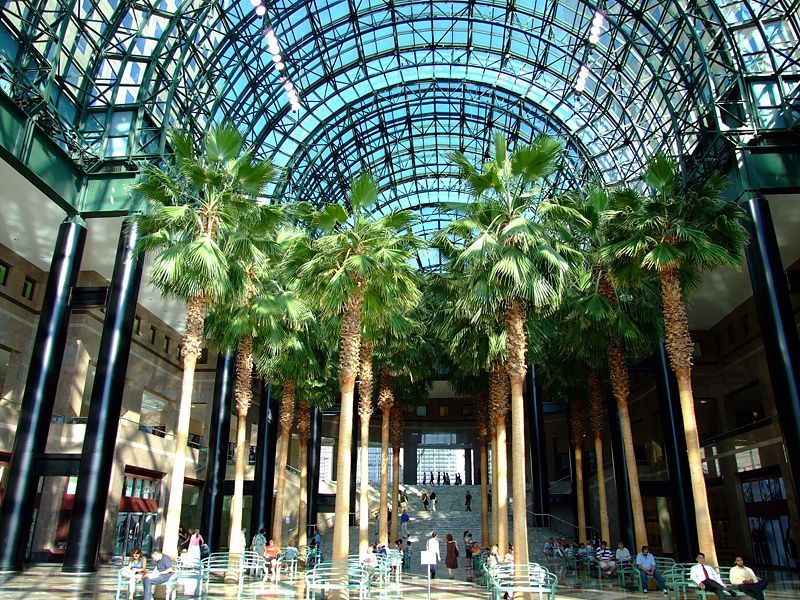New York City-
8/17/11
-8/20/11
|
Day 1-Wednesday |
Day 2- Thursday |
Day 3 - Friday |
Day 4- Saturday |
Day 4- World Trade
Center-Ground Zero
The World Trade Center site, also
known as "Ground Zero" after the September 11, 2001 attacks, sits on 16 acres in
Lower Manhattan. The World Trade Center complex stood on this site until
it was destroyed in the attacks. 10 years after the site is still under
construction. A whole section is blocked so my aunt knew the way and she
let us through a building and we saw ground zero from a window of a large building nearby.
|

The tall building you see in the
middle and under construction will be the new One World trade center. |

Lots of construction going around!
I think they try to be ready for the 10th anniversary which is about 3
weeks away. |

Close look at all the construction going on
at the site.
This a better view of the future One World
Trade Center (1 World Trade Center).
The tower is being constructed in the
northwest corner of the World Trade Center site, occupying the location where
the original 8-story 6 World Trade Center once stood.
Winter Garden
Atrium

The Winter Garden Atrium is a 10-story
glass-vaulted pavilion in the World Financial Center. Originally constructed in
1988, and substantially rebuilt in 2002, the Atrium houses various plants, trees
and flowers, and shops.
The Atrium was severely damaged in the
September 11, 2001 attacks but was rebuilt during the first year of the
Financial Center's recovery. Reconstruction of the Winter Garden required 2,000
panes of glass, 60,000 square feet (5,400 mē) of marble flooring and stairs, and
16 40-foot (12 m) palm trees at a cost $50 million. Reopened on September 17,
2002, the Winter Garden was the first major structure to be completely restored
following the attacks.
Inside the Winter Garden
atrium. The palm trees and the marble flooring was gorgeous.
The rear of the building opens onto the World Financial Center Plaza and the
North Cove Yacht Harbor on the Hudson River.

Pretty amazing place!
The palm trees are about 40 foot tall but
they are not even close to the atrium (10 story high).
My aunt said in the winter they rent this
place out for gala or huge event.

As you step of the atrium is the
Yacht Harbor on the Hudson River.
Ellis Island is in the back ground.

Lots of people walking around,
biking, and relaxing..
This is a pretty nice view.

Lots of yachts around...
|

|

Financial district with all the tall
buildings. |

View of the city from the Hudson river.
The Irish Hunger
Memorial
The Irish Hunger Memorial, is located on a
one-half acre site at the corner of Vesey Street and North End Avenue in the
Battery Park City neighborhood of Manhattan and is dedicated to raising
awareness of the Great Irish Famine that killed up to a million people in Ireland
between 1845 and 1852. The memorial was dedicated on July 16, 2002.
Many who survived the famine did so because they
emigrated to the United States. The site is also of great historical
importance to those tracing their Irish heritage, 800,000 of whom now call New
York City home
|

|

Passageway connecting the west side to the ruined stone cottage and the roof.
|
The exterior wall of
the memorial is covered by almost two miles of illuminated text of famine
poems, statistics and quotes.

Uncle Larry explaining that this the
entrance of an Irish cottage..
The memorial also incorporates an
authentic rebuilt Irish cottage of the 19th century.
The cottage belonged to the Slack family but
was deserted in the 1960s. The Slack family donated the cottage to the memorial
in "memory of all the Slack family members of previous generations who emigrated
to America and fared well there.
Fireplace in a
cottage in Ireland. The stones are from all of the different counties of
Ireland.
Design to look like a garden in Ireland...
It is a uniquely landscaped plot, which
utilizes stones, soil, and native vegetation brought in from the western coast
of Ireland.
During the famine
anyone who owned more than a half-acre of land was not eligible for any aid or
relief.
Many of the starving
were poor but owned a half-acre, forcing them to abandon their homes in order to
obtain food.
Very interesting place to see. This
is the roof top overseeing the Hudson river.


Next...
Brooklyn































